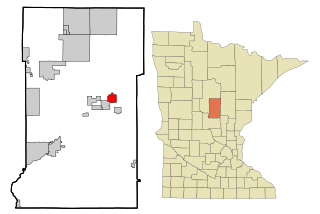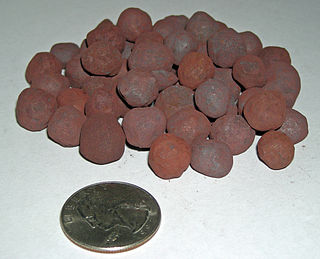
Crow Wing County is a county in the East Central part of the U.S. state of Minnesota. As of the 2020 census, the population was 66,123. Its county seat is Brainerd. The county was formed in 1857, and was organized in 1870.

Crosby is a city in Crow Wing County, Minnesota, United States. The population was 2,386 at the 2010 census. It is part of the Brainerd Micropolitan Statistical Area. Crosby is adjacent to its twin city of Ironton, in the Cuyuna iron range.

Cuyuna is a city in Crow Wing County, Minnesota, United States. The population was 332 at the 2010 census. It is part of the Brainerd Micropolitan Statistical Area.

Trommald is a city in Crow Wing County, Minnesota, United States. The population was 99 at the 2020 census. It is part of the Brainerd Micropolitan Statistical Area.

The Mesabi Iron Range is a mining district and mountain range in northeastern Minnesota following an elongate trend containing large deposits of iron ore. It is the largest of four major iron ranges in the region collectively known as the Iron Range of Minnesota. First described in 1866, it is the chief iron ore mining district in the United States. The district is located largely in Itasca and Saint Louis counties. It has been extensively worked since 1892, and has seen a transition from high-grade direct shipping ores through gravity concentrates to the current industry exclusively producing iron ore (taconite) pellets. Production has been dominantly controlled by vertically integrated steelmakers since 1901, and therefore is dictated largely by US ironmaking capacity and demand.

The Iron Range is collectively or individually a number of elongated iron-ore mining districts around Lake Superior in the United States and Canada. Much of the ore-bearing region lies alongside the range of granite hills formed by the Giants Range batholith. These cherty iron ore deposits are Precambrian in the Vermilion Range and middle Precambrian in the Mesabi and Cuyuna ranges, all in Minnesota. The Gogebic Range in Wisconsin and the Marquette Iron Range and Menominee Range in Michigan have similar characteristics and are of similar age. Natural ores and concentrates were produced from 1848 until the mid-1950s, when taconites and jaspers were concentrated and pelletized, and started to become the major source of iron production.

Central Minnesota is the central part of the state of Minnesota. No definitive boundaries of the region exist, but most definitions would include the land north of Interstate 94, east of U.S. Highway 59, south of U.S. Highway 2, and west of U.S. Highway 169.

The Vermilion Range exists between Tower, Minnesota and Ely, Minnesota, and contains significant deposits of iron ore. Together with the Mesabi, Gunflint, and Cuyuna ranges, these four constitute the Iron Ranges of northern Minnesota. While the Mesabi Range had iron ore close enough to the surface to enable pit mining, mines had to be dug deep underground to reach the ore of the Vermilion and Cuyuna ranges. The Soudan mine was nearly 1/2 mile underground and required blasting of Precambrian sedimentary bedrock.

The Cuyuna Range is an inactive iron range to the southwest of the Mesabi Range, largely within Crow Wing County, Minnesota. It lies along a 68-mile-long (109 km) line between Brainerd, Minnesota, and Aitkin, Minnesota. The width ranges from 1 to 10 miles.

Cuyuna Country State Recreation Area (CCSRA) is a state park unit of Minnesota, USA, being developed to rehabilitate a portion of the Cuyuna Range where mining pits and piles of waste rock were left behind after decades of open-pit mining for iron ore. Abandoned by mining companies more than 20 years ago, the state recreation area consists of regenerated vegetation and clear lakes that draw a wide range of recreation enthusiasts. The park is located off Minnesota State Highway 210, near the towns of Crosby, Ironton and Cuyuna. The Croft Mine Historical Park, formerly city-run, is now part of the state recreation area.

Portsmouth Mine Pit Lake, sometimes called the Portsmouth Pit, is the deepest lake completely within the state of Minnesota, USA. It has a depth of over 450 feet (137 m), according to the most recent Minnesota DNR data. Lake Superior, over 700 feet deep off the north shore of the state, is technically deeper. The 120-acre (49 ha) artificial lake is a former iron mining pit in the Cuyuna Range that has since filled with water.

Manganese is a ghost town and former mining community in the U.S. state of Minnesota that was inhabited between 1912 and 1960. It was built in Crow Wing County on the Cuyuna Iron Range in sections 23 and 28 of Wolford Township, about 2 miles (3 km) north of Trommald, Minnesota. After its formal dissolution, Manganese was absorbed by Wolford Township; the former town site is located between Coles Lake and Flynn Lake. First appearing in the U.S. Census of 1920 with an already dwindling population of 183, the village was abandoned by 1960.

This is a list of the National Register of Historic Places listings in Crow Wing County, Minnesota. It is intended to be a complete list of the properties and districts on the National Register of Historic Places in Crow Wing County, Minnesota, United States. The locations of National Register properties and districts for which the latitude and longitude coordinates are included below, may be seen in an online map.

Ironton Sintering Plant Complex is a group of buildings north of Crosby, Minnesota, United States, listed on the National Register of Historic Places. The plant was built in 1924 by the Hanna Mining Company to sintering iron ore mined in the Cuyuna Range. The mining industry, after 1900, was seeking to exploit lower-grade iron deposits to meet the increasing demand of the iron and steel industry. To bring the ore to customers' specifications, the mines sought to "beneficiate" the ore through sintering, crushing, and washing. The sintering process was unique to the Cuyuna Range and made it possible to economically support mining.

The Pittsburgh-Des Moines Steel Company, and often referred to as Pitt-Des Moines Steel or PDM was an American steel fabrication company. It operated from 1892 until approximately 2002 when its assets were sold to other companies, including Chicago Bridge & Iron Company. The company began as a builder of steel water tanks and bridges. It also later fabricated the "forked" columns for the World Trade Center in the 1960s, and was the steel fabricator and erector for the Gateway Arch in St. Louis. A number of its works are listed on the National Register of Historic Places.

Iron mining in the United States produced 48 million metric tons of iron ore in 2019. Iron ore was the third-highest-value metal mined in the United States, after gold and copper. Iron ore was mined from nine active mines and three reclamation operations in Michigan, Minnesota, and Utah. Most of the iron ore was mined in northern Minnesota's Mesabi Range. Net exports were 3.9 million tons. US iron ore made up 2.5 percent of the total mined worldwide in 2015. Employment as of 2014 was 5,750 in iron mines and iron ore treatment plants.

The Spina Hotel is a historic former hotel building in Ironton, Minnesota, United States. It was built in 1913 with multiple commercial spaces and grandly designed architecture. The building was listed on the National Register of Historic Places in 1980 for having local significance in the themes of architecture and commerce. It was nominated for illustrating the scale of civic development anticipated but never fully achieved during the boom years of iron mining on the Cuyuna Range.

Ironton City Hall is a historic municipal building in Ironton, Minnesota, United States. It was built in 1917 to house the city's offices, fire department, library, jail, and an auditorium that hosted numerous community organizations and events. Ironton City Hall was listed on the National Register of Historic Places in 2002 for having local significance in the themes of politics/government and social history. It was nominated for being the longstanding focal point of Ironton's government services and community activities.

The Ogilvie Watertower is a historic water tower in Ogilvie, Minnesota, United States, built in 1918. It was listed on the National Register of Historic Places in 1980 for having local significance in the themes of engineering and social history. It was nominated for being a rare surviving example of Minnesota's earliest reinforced concrete water towers and a symbol of the local infrastructure improvements that enabled the organization of Ogilvie's fire department.



















